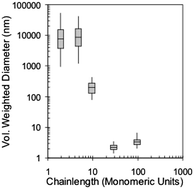Concentrated aqueous synthesis of nanoparticles using comb-graft copolymer stabilisers: the effect of stabiliser architecture
Abstract
Silver nanoparticles have been synthesised at high concentration (>1 mol L−1) in water using a series of comb-graft copolymers. The copolymers were synthesised and then derivatised from methoxypoly(ethylene glycol) acrylate and maleic anhydride. The degree of polymerisation (number of backbone units), the nature of the adsorption group and length (MW) of the steric component were all found to be critical to the stabilisation of the nanoparticles during synthesis. The results demonstrate that a minimum steric length is required to prevent particle aggregation during synthesis. For Ag particles less than 30 nm in diameter, this corresponded to a polyethylene glycol (PEG) chain with a molecular weight of 454 g mol−1. It was shown that stabiliser molecules with a low number of backbone units were readily displaced, whereas stabilisers that possess numerous adsorption groups bind irreversibly to the particle surface. Adsorption groups were modified to test both chemisorption and physisorption functionality. Chemisorbed species were shown to be more effective stabilisers whereby concentrated Ag nanoparticles were synthesised at a smaller particle size. This was attributed to the adsorption strength and greater diffusive capabilities of the molecule.


 Please wait while we load your content...
Please wait while we load your content...